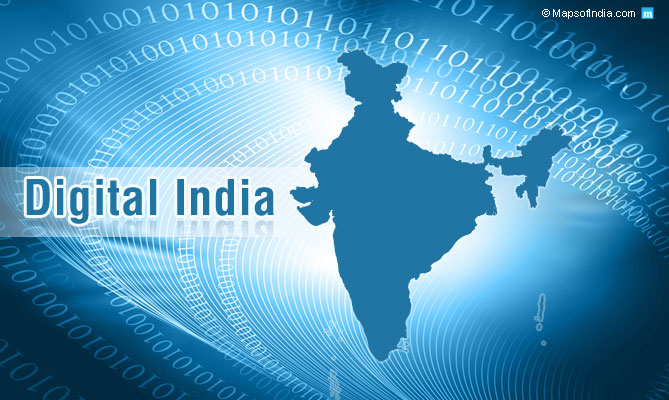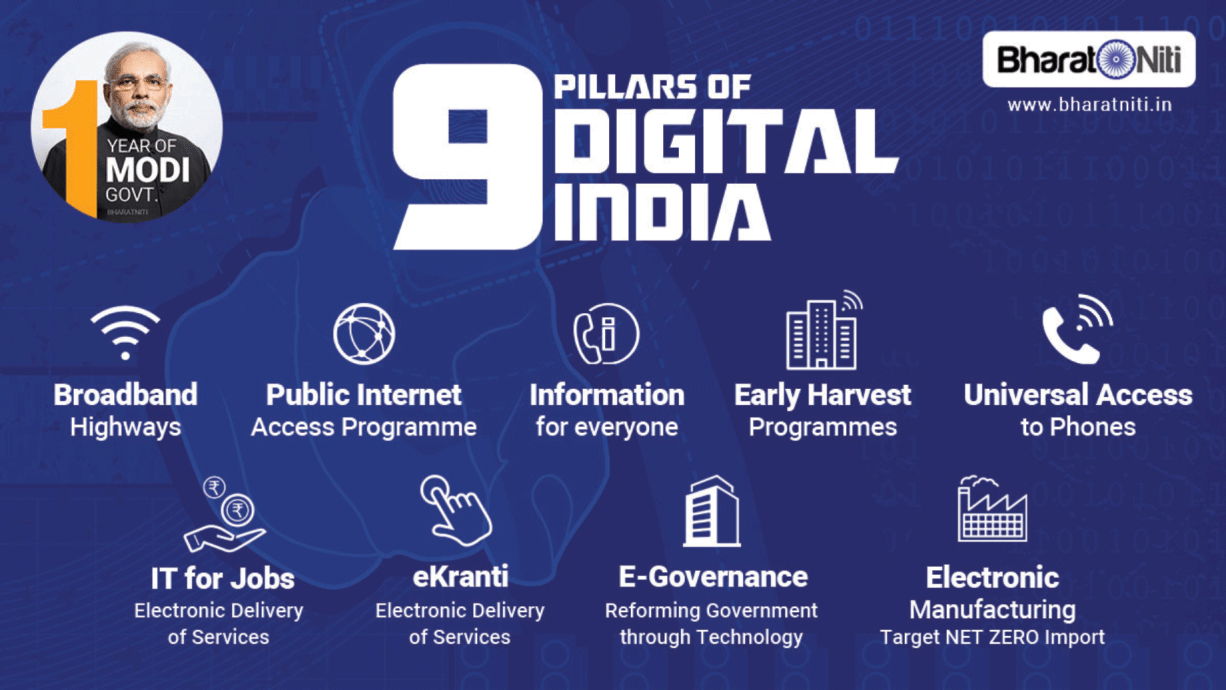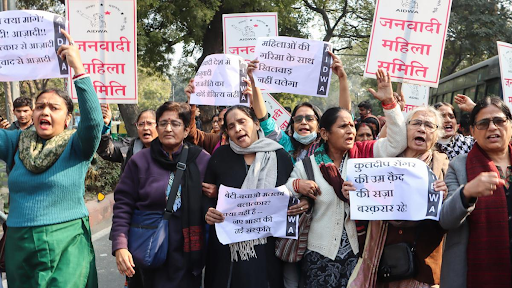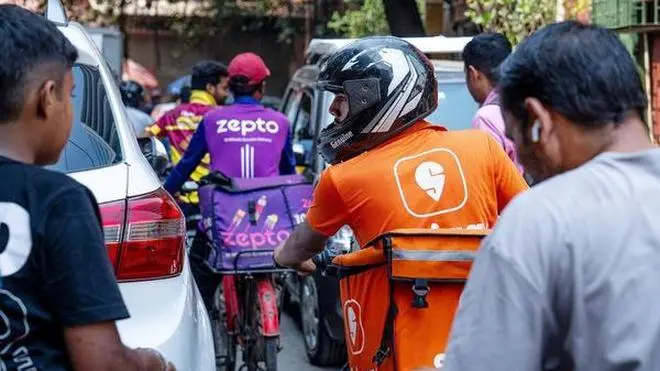Description

Copyright infringement not intended
Picture Courtesy: MapsofIndia
Context: The Union Cabinet led by Prime Minister, has given its approval for the expansion of the Digital India program. This expansion is backed by a total budget of ₹14,903 crore. The Digital India program, originally launched on July 1, 2015, aims to facilitate the delivery of government services through digital means and promote digital literacy and technology adoption across India.
Details
- The allocated budget of ₹14,903 crore will support various initiatives that aim to further enhance the digital infrastructure and capabilities of the nation.
These initiatives include
- Re-skilling and Up-skilling IT Professionals: Around 6.25 lakh IT professionals will undergo re-skilling and up-skilling through the FutureSkills Prime Programme. This initiative aims to equip the workforce with the necessary skills to stay relevant in the rapidly evolving technology landscape.
- Information Security Training: Approximately 2.65 lakh individuals will receive training in information security through the Information Security & Education Awareness Phase (ISEA) Programme. This effort will bolster the country's cybersecurity preparedness.
- Expansion of UMANG App: An additional 540 services will be integrated into the Unified Mobile Application for New-age Governance (UMANG) app/platform. This expansion will provide citizens with access to a wider range of government services through a single digital platform.
- National Super Computer Mission: The National Super Computer Mission will be augmented with the addition of 9 new supercomputers, in addition to the 18 already deployed. This will contribute to advancing scientific research and computational capabilities.
- Bhashini AI-enabled Translation Tool: The Bhashini AI-enabled multi-language translation tool will be extended to cover all 22 scheduled languages, enhancing communication across diverse linguistic groups.
- Modernization of National Knowledge Network (NKN): The National Knowledge Network, which links educational institutions, will be modernized to improve connectivity and collaboration in the academic sector.
- DigiLocker Access for Organizations: The digital document verification facility offered by DigiLocker will be extended to Micro, Small, and Medium Enterprises (MSMEs) and other organizations, streamlining their document management processes.
- Support for Startups: Support will be provided to 1,200 startups in Tier 2 and Tier 3 cities, fostering innovation and entrepreneurship beyond major metropolitan areas.
- AI-focused Centers of Excellence: Three Centers of Excellence in Artificial Intelligence (AI) will be established, focusing on healthcare, agriculture, and sustainable cities. These centres will drive research and innovation in critical sectors.
- Cybersecurity Initiatives: Cyber-awareness courses for 12 crore college students and new cybersecurity initiatives, including the development of tools and integration with the National Cyber Coordination Centre, will bolster the nation's cybersecurity capabilities.
Overall, these initiatives will not only contribute to the growth of the digital economy but also promote inclusivity, innovation, and security in India's digital landscape.

Digital India program
About
- The Digital India program was launched on July 1, 2015, by the Government of India. The program aims to transform India into a digitally empowered society and knowledge economy. It seeks to harness the potential of information technology and digital platforms to provide government services to citizens, promote digital literacy, and foster innovation and entrepreneurship.
Features
- Broadband Connectivity: Expanding high-speed internet connectivity to rural and remote areas is essential to bridge the digital divide. This initiative aims to provide equal access to information and opportunities for citizens across the country, regardless of their geographical location.
- Digital Infrastructure: Developing robust digital infrastructure, including data centres, cloud platforms, and networks, is the foundation of a digitally-driven nation. This infrastructure supports various digital services, applications, and platforms, enabling efficient data storage, processing, and sharing.
- e-Governance: Transitioning government services and benefits to electronic platforms improves efficiency, transparency, and accessibility. Citizens can access services online, reducing paperwork, eliminating intermediaries, and enhancing the overall service delivery experience.
- Digital Literacy: Promoting digital literacy is crucial, especially in rural areas where many citizens might not be familiar with digital tools. Digital literacy campaigns and training programs help individuals gain the skills needed to navigate the digital landscape effectively.
- Universal Access to Phones: Ensuring that every citizen has access to mobile phones facilitates their engagement with digital services and platforms. Mobile phones become a gateway to information, communication, and services.
- Public Internet Access: Establishing Common Service Centers (CSCs) in rural areas provides public Internet access and government services under one roof. These centres act as touchpoints for citizens to avail of various digital services without having to travel to urban centres.
- Digital Payment Systems: Promoting digital payment systems is a significant step towards reducing cash transactions, promoting transparency, and formalizing the economy. Platforms like BHIM and UPI have revolutionized the way transactions are conducted.
- Digital Identity: Aadhaar, a biometric identification system, provides citizens with a unique digital identity. This identity simplifies access to government services, eliminates duplications, and enhances the efficiency of service delivery.
- Startup and Innovation: Fostering a conducive environment for startups and innovation in the technology sector drives economic growth and creates job opportunities. Initiatives like "Startup India" encourage entrepreneurship and technological advancement.

Significance
- Inclusive Growth: Bridging the digital divide is essential for inclusive growth. The Digital India program aims to ensure that every citizen, regardless of their location or socio-economic background, can access and benefit from digital services. This empowers marginalized communities and brings them into the mainstream of technological advancement and economic opportunities.
- Efficient Service Delivery: By offering government services online, the program streamlines administrative processes and reduces bureaucratic hurdles. Citizens can access services from the comfort of their homes, saving time and effort. This efficient service delivery enhances citizen satisfaction and builds trust in the government's ability to respond effectively.
- Economic Growth: The promotion of innovation, entrepreneurship, and the growth of the IT sector has a direct impact on the economy. Digitalization leads to the creation of new industries, products, and services, generating jobs and contributing to economic growth. Moreover, as businesses adopt digital practices, productivity and efficiency increase.
- Transparency: Digitizing processes and making services available online reduces the scope for intermediaries and corruption. Transactions and interactions become more traceable and accountable, fostering greater transparency in government operations. This transparency builds public trust and confidence in the system.
- Digital Literacy: Enhancing digital literacy equips citizens with the skills needed to navigate the digital landscape. In today's technology-driven world, digital literacy is a fundamental skill that empowers individuals to access information, communicate effectively, and participate in the digital economy. It also prepares the workforce for the jobs of the future
Challenges
- Digital Divide: The unequal access to technology and internet connectivity between urban and rural areas is a significant challenge. While urban centres usually have better access to high-speed internet, rural and remote areas often lack reliable connectivity. This divide limits the benefits of digital services and information dissemination to those who need it most.
- Digital Illiteracy: A considerable portion of the population lacks the necessary digital skills to effectively use digital platforms, tools, and services. This hinders their ability to fully engage in the digital ecosystem, access government services, and benefit from technological advancements.
- Cybersecurity Concerns: As digital transactions and interactions increase, the risk of cyber threats and data breaches also grows. Ensuring the security of digital systems, protecting personal data, and educating citizens about online safety become paramount to prevent fraud, identity theft, and other cybercrimes.
- Infrastructure Gaps: Building robust digital infrastructure is essential for the success of digital initiatives. However, challenges in terms of setting up data centres, expanding network coverage, and maintaining the infrastructure in remote areas can impede progress. Without adequate infrastructure, delivering digital services becomes difficult.
- Linguistic Diversity: India's linguistic diversity poses a unique challenge when it comes to developing localized digital content. To ensure that digital services are accessible and relevant to all citizens, content must be available in multiple languages. This requires significant efforts in translation and localization.
Way Forward
- Infrastructure Investment: Continued investment in digital infrastructure is crucial to ensure that connectivity reaches all corners of the country. This includes expanding broadband networks, improving mobile coverage, and establishing data centres that can support the increasing demand for digital services.
- Digital Skill Training: Focusing on digital literacy and training across all age groups is essential. Educational programs and workshops should be designed to equip citizens with the skills needed to effectively use digital tools and platforms. This empowers individuals to participate more fully in the digital economy.
- Cybersecurity Measures: Enhancing cybersecurity measures and data protection is paramount as digital interactions increase. This involves developing strong encryption standards, promoting safe online practices, and implementing regulations that safeguard user data and privacy.
- Local Language Content: Creating digital content in various languages is critical to ensuring that digital services are accessible to all citizens, regardless of their linguistic background. This includes translating government websites, applications, and other content into regional languages.
- Innovation Ecosystem: Fostering a supportive environment for startups and innovation is essential for the growth of the digital economy. Providing incentives, access to funding, and mentorship can encourage entrepreneurs to develop innovative solutions that address unique Indian challenges.

Conclusion
- The Digital India program embodies the nation's journey towards technological empowerment. As progress unfolds, the imperative of bridging the digital divide becomes evident, necessitating robust infrastructure expansion and localized content creation. Equipping citizens with digital skills and fortifying cybersecurity measures stand as linchpins in ensuring the program's efficacy. Ultimately, the program's triumph holds the potential to not only catalyze economic growth but also uplift the quality of life for millions, epitomizing India's dynamic leap into the digital age.
Must-Read Articles:
Digital India Week 2022: https://www.iasgyan.in/daily-current-affairs/digital-india-week-2022-38#:~:text=The%20Digital%20India%20Week%202022,will%20participate%20in%20this%20programme.
|
PRACTICE QUESTION
Q. How does the Digital India program address diverse aspects, including broadband connectivity, digital literacy, and innovation promotion, to bridge the digital gap and foster economic progress? In light of challenges like digital illiteracy, cybersecurity risks, and linguistic variations, how can the program's strategies, such as infrastructure investment and localized content creation, effectively tackle these obstacles and contribute to India's evolution into a technologically empowered society?
|
https://pib.gov.in/PressReleasePage.aspx?PRID=1949426













